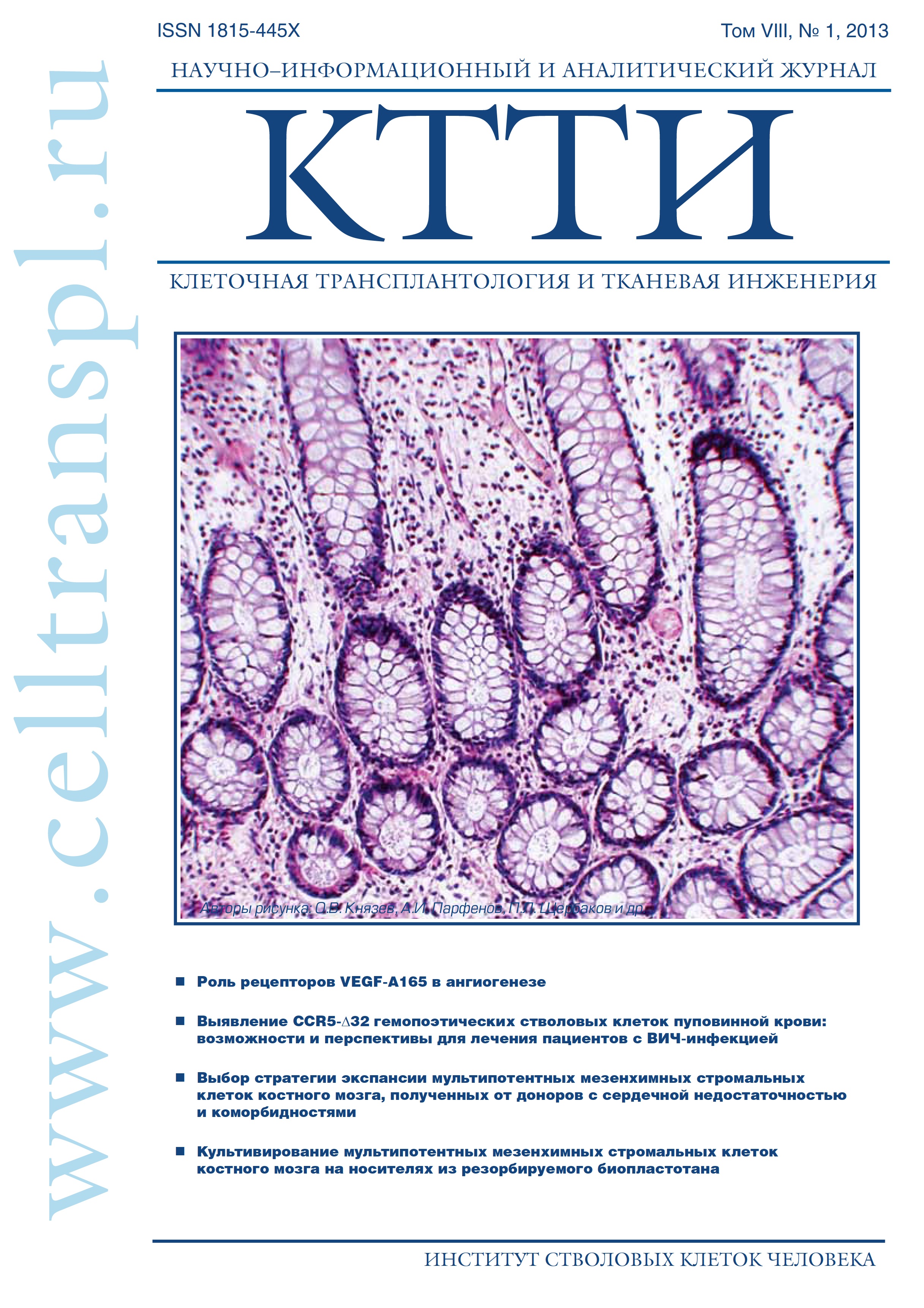Decellularized human umbilical arteries as a potential scaffold for small diameter tissue engineered vascular grafts
- Authors: Nasredinov A.S1, Lavreshin A.V1, Anisimov S.V1, Vavilov V.N1, Kurapeev D.I1
-
Affiliations:
- V.A. Almazov Federal Heart, Blood and Endocrinology Centre, Saint-Petersburg
- Issue: Vol 8, No 1 (2013)
- Pages: 66-71
- Section: Articles
- URL: https://genescells.ru/2313-1829/article/view/121617
- DOI: https://doi.org/10.23868/gc121617
- ID: 121617
Cite item
Abstract
Last advances in tissue engineering are connected with the possibility of obtaining decellularized organs and tissues. Their remaining mechanical strength and native structure make them convenient for subsequent recellularization. Decellularization methods vary a lot depending on the kind of the source tissue. We have developed original decellularization method for human umbilical arteries as a potential scaffold for small diameter tissue engineered vascular graft. Effectiveness of decellularization was evaluated by the means of histological and immunogistochemistrical assays, also by estimation of DNA and RNA quantities. These decellularized vessels can be used as scaffolds for cells in frame of tissue engineering vascular grafts making, which demanded in reconstructive cardiovascular surgery.
Full Text
About the authors
A. S Nasredinov
V.A. Almazov Federal Heart, Blood and Endocrinology Centre, Saint-Petersburg
A. V Lavreshin
V.A. Almazov Federal Heart, Blood and Endocrinology Centre, Saint-Petersburg
S. V Anisimov
V.A. Almazov Federal Heart, Blood and Endocrinology Centre, Saint-Petersburg
V. N Vavilov
V.A. Almazov Federal Heart, Blood and Endocrinology Centre, Saint-Petersburg
D. I Kurapeev
V.A. Almazov Federal Heart, Blood and Endocrinology Centre, Saint-Petersburg
References
- World Health Organization. World health statistics 2012. WHO Press 2012: 176.
- Campbell G.R., Campbell J.H. Development of Tissue Engineered Vascular Grafts. Current Pharmaceutical Biotechnology 2007; 8: 43-50.
- Naito Y., Shinoka T., Duncan D. et al. Vascular tissue engineering: towards the next generation vascular grafts. Advanced Drug Delivery Reviews 2011; 63(4-5): 312-23.
- Thomas A.C., Campbell G. R., Campbell J.H. Advances in vascular tissue engineering. Cardiovascular Pathology 2003; 12: 271-6.
- Ахмедов Ш.Д., С.А. Афанасьев, М.Л. Дьякова и др. Использование бесклеточного матрикса для формирования новых кровеносных сосудов и сердца методом тканевой инженерии. Клеточная трансплантология и тканевая инженерия 2009; IVt2): 32-9.
- Quint C., Kondo Y., Manson R.J. et al. Decellularized tissue-engineered blood vessel as an arterial conduit. PNAS USA 2011; 108(22): 9214-9.
- Nerem R.M., Seliktar D. Vascular tissue engineering. Annu. Rev. Biomed. Eng. 2001; 3: 225-43.
- Baguneid M.S., Seifalian A.M., Salacinski H.J. Tissue engineering of blood vessels. Brit. J. Surg. 2006; 93: 282-90.
- Boccafoschi F., Habermehl J., Vesentini S. et al. Biological performances of collagen-based scaffolds for vascular tissue engineering. Biomaterials 2005; 26t35): 7410-7.
- Erdbrugger W., Konertz W., Dohmen P.M. et al. Decellularized xenogenic heart valves reveal remodeling and growth potential in vivo. Tissue Engineering 2006; 12(8): 2059-68.
- Zhao Y., Zhang S., Zhou J. et al. The development of a tissue-engineered artery using decellularized scaffold and autologous ovine mesenchymal stem cells. Biomaterials 2010; 31: 296-307.
- Crapo P.M., Gilbert T.W., Badylak S.F. An overview of tissue and whole organ decellularization processes. Biomaterials 2011; 32: 3233-43.
- Zou Y., Zhang Y. Mechanical evaluation of decellularized porcine thoracic aorta. J. Surg. Res. 2012; 2(175): 1-10.
- Fitzpatrick J.C., Clark P.M., Capaldi F.M. Effect of decellularization protocol on the mechanical behavior of porcine descending aorta. Int. J. Biomat. 2010: 1-11.
- Rieder E., M.-T. Kasimir, G. Silberhumer et al. Decellularization protocols of porcine heart valves differ importantly in efficiency of cell removal and susceptibility of the matrix to recellularization with human vascular cells. J. Thor. Cardiovasc. Surg. 2004; 127t2): 399-405.
- Williams C., Liao J., Joyce E.M. et al. Altered structural and mechanical properties in decellularized rabbit carotid arteries. Acta Biomaterialia 2009; 5: 993-1005
- Ott H.C, Matthiesen T.S, Goh S. et al. Perfusion-decellularized matrix: using nature's platform to engineer a bioartificial heart. Nature Medicine 2008; 14(2): 213-21.
- Guo-feng L., Zhi-juan H.E., Da-ping Y.et al. Decellularized aorta of fetal pigs as a potential scaffold for small diameter tissue engineered vascular graft. Chin. Med. J. 2008; 121(15): 1398-406.
- Smith A.N. Characterization and implementation of a decellularized porcine vessel as a biologic scaffold for a blood vessel mimic [dissertation]. San Luis: California Polytechnic State Univ. 2011, 196 p.
- Dong J., Huang J. Mesenchymal stem cell-based tissue engineering of small-diameter blood vessels. Vascular 2011; 19(4): 206-13.
- Roy S., Silacci P., Stergiopulos N. Biomechanical proprieties of decellularized porcine common carotid arteries. Am. J. Physiol. Heart Circ. Physiol. 2005; 289: 1567-76.
- Gui L., Muto A., Chan S.A. et al. Development of decellularized human umbilical arteries as small-diameter vascular grafts. Tissue engineering 2009; 15(Pt A): 2665-76.
- Daniel J., Abe K., McFetridge P.S. Development of the human umbilical vein scaffold for cardiovascular tissue engineering applications. ASAIO 2005; 3: 251-62.
Supplementary files










